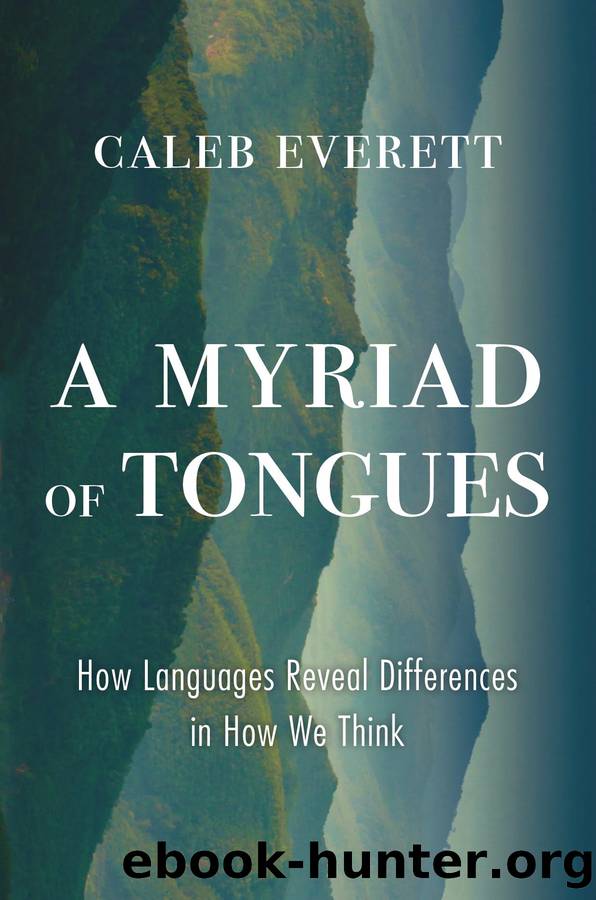A Myriad of Tongues by Caleb Everett

Author:Caleb Everett
Language: eng
Format: epub
Publisher: Harvard University Press
Words Adapt
In the Introduction I mentioned the famous (perhaps infamous) observation that the Inuit have many basic words for snow. While their number of words for snow has been exaggerated and distorted in the zeitgeist, the larger point that this observation underscores, namely that the words of languages adapt to environmental factors, seems commonsensical. Yet common sense does not replace research and can mislead us in serious ways. Consider again the example of words for snow. What predictions might common sense truly make here? If a group of people lives in a very snowy locale, perhaps snow becomes such a pervasive facet of the environmental background that it is less salient, and maybe even less worth thinking and talking about, and therefore less likely to be encoded with many words. Or perhaps the pervasiveness of snow implies that people are likely to think and talk about it a lot, and as a result they need to make fine-grained distinctions that ultimately result in many words for the phenomenon. This latter prediction is the one associated with the words-for-snow trope. These divergent predictions made by âcommon senseâ have been stressed in work on this topic by cognitive scientist Terry Regier.6
Regier and his colleagues decided to tackle this topic not with intuition but with big data and computational methods. They took to Twitter, analyzing tweets in diverse languages spoken in both warm and cold regions. They found that people in cold places tend to talk much more about snow and ice than speakers of the same language residing in warmer places, at least judging from their tweets. This suggests that snow and ice are not simply boring background phenomena that are unworthy of thought or conversation, but rather that they are frequently highlighted in speech in cold places. The researchers then addressed another related question: Do languages in warmer places tend to make distinctions between âsnowâ and âice,â or do they tend to conflate these words for crystalline water? This is the natural counterpart to the question made famous by the work of Boas and others. Regierâs team addressed the issue with a direct approach: they examined words for snow and ice in about two hundred languages representing many diverse language families and geographic regions. They observed that most languages have distinct words for ice and snow, as in English. In about one-sixth of the languages surveyed, however, no such distinction was made. These languages were spoken only in warm geographic regions. To rule out the possibility of coincidence, the researchers looked at nearly one thousand other word types to test whether the warm-weather languages just happened to make less fine-grained distinctions for a variety of phenomena, including air and wind. The team of researchers observed that while many languages do not have separate basic words for air and wind, such languages are spoken in both warm and colder regions. Out of all the word pairs they examined, the ice / snow pair was clearly an outlier. Ice and snow are distinguished
Download
This site does not store any files on its server. We only index and link to content provided by other sites. Please contact the content providers to delete copyright contents if any and email us, we'll remove relevant links or contents immediately.
Cecilia; Or, Memoirs of an Heiress — Volume 1 by Fanny Burney(32434)
Cecilia; Or, Memoirs of an Heiress — Volume 2 by Fanny Burney(31868)
Cecilia; Or, Memoirs of an Heiress — Volume 3 by Fanny Burney(31851)
The Lost Art of Listening by Michael P. Nichols(7403)
Asking the Right Questions: A Guide to Critical Thinking by M. Neil Browne & Stuart M. Keeley(5630)
We Need to Talk by Celeste Headlee(5542)
On Writing A Memoir of the Craft by Stephen King(4863)
Dialogue by Robert McKee(4321)
Pre-Suasion: A Revolutionary Way to Influence and Persuade by Robert Cialdini(4142)
I Have Something to Say: Mastering the Art of Public Speaking in an Age of Disconnection by John Bowe(3838)
Elements of Style 2017 by Richard De A'Morelli(3306)
The Book of Human Emotions by Tiffany Watt Smith(3237)
Fluent Forever: How to Learn Any Language Fast and Never Forget It by Gabriel Wyner(3024)
Name Book, The: Over 10,000 Names--Their Meanings, Origins, and Spiritual Significance by Astoria Dorothy(2938)
Good Humor, Bad Taste: A Sociology of the Joke by Kuipers Giselinde(2902)
Why I Write by George Orwell(2874)
The Art Of Deception by Kevin Mitnick(2735)
The Grammaring Guide to English Grammar with Exercises by Péter Simon(2706)
Ancient Worlds by Michael Scott(2622)
